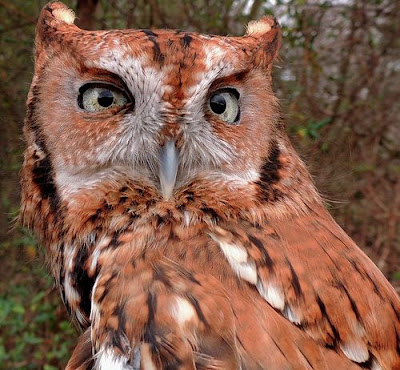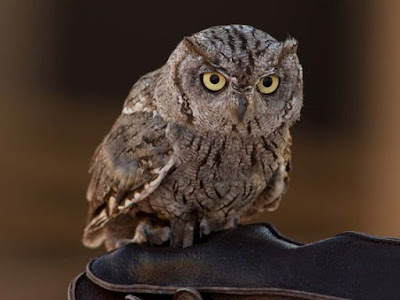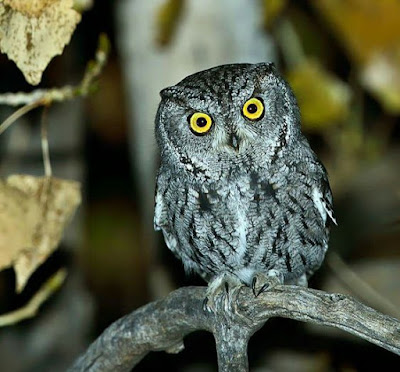Screech owls or screech-owls are typical owls (Strigidae) belonging to the genus Megascops. Twenty-one living species are known at present, but new ones are frequently recognized and unknown ones are still being discovered on a regular basis, especially in the Andes. For most of the 20th century, this genus was merged with the Old World scops owls in Otus, but nowadays it is again considered separate based on a range of behavioral, biogeographical, morphological and DNA sequence data.
Screech owls are restricted to the Americas. Some species formerly placed with them are nowadays considered more distinct (see below for details). The common name "screech owl" is sometimes used for the not closely related barn owl as well.
Description
Similar to other owls, the screech owl females are larger than the males of their species. They have a compact size and shape. The screech owls are small and agile. They are about 7 to 10 inches tall and have a wingspan of about 18 to 24 inches. They have prominent, wide-set feather tufts with bright yellow/green eyes. They have different brownish hues with whitish, patterned underside. This coloration helps them get camouflage against the tree bark. They have well-developed raptorial claws and curved bill. They use them as a tool to tear their prey into pieces that are small enough for them to swallow. They tend to carry their prey to the nest and then eat it.
Screech owls hunt from perches in semi-open landscapes. They prefer areas which contain old trees with hollows; these are home to their prey which includes insects, reptiles, small mammals such as bats and mice and other small birds. Screech-owls have a good sense of hearing which helps them locate their prey in any habitat. They also possess well-developed raptorial claws and a curved bill, both of which are used for tearing their prey into pieces small enough to swallow easily. They usually carry their prey back to their nests, presumably to guard against the chance of losing their meal to a larger raptor.
Screech owls are primarily solitary. During the late winter breeding season, however, males make nests in cavities, sometimes reusing abandoned nests of other animals, to try to attract females. The females select their mate based on the quality of the cavity and the food located inside. During the incubation period, the male feeds the female. These birds are monogamous, with biparental care. The young of most screech owls are altricial to semi altricial.
The northern screech-owls are found in eastern states, such as New Jersey and New York. The screech owls are named for their piercing calls. The normal territorial call is not a hoot as with some owls, but a trill consisting of more than 4 individual calls per second given in rapid succession. They also have a kind of "song" which is used in courtship and, as a duet, between members of a pair. Calls differ widely between species in type and pitch, and in the field are often the first indication of these birds' presence, as well as the most reliable means to distinguish between species. The distinctness of many species of screech owls was first realized when vastly differing calls of externally similar birds from adjacent regions were noted.
Evolution,Taxonomy and Systematics
The genus was introduced by the German naturalist Johann Jakob Kaup in 1848.The type species is the eastern screech owl (Megascops asio).The evolutionary relationships of the scops and screech owls are not entirely clear. What is certain is that they are very closely related; they may be considered sister lineages which fill essentially the same ecological niche in their allopatric ranges. A screech owl fossil from the Late Pliocene of Kansas indicates a longstanding presence of these birds in the Americas, while coeval scops owl fossils very similar to the Eurasian scops owl have been found at S'Onix on Majorca.The scops and screech owl lineage probably evolved at some time during the Miocene (like most other genera of typical owls), and the three modern lineages separated perhaps roughly 5 million years ago. Note that there is no reliable estimate of divergence time, as Otus and Megascops are osteologically very similar, as is to be expected from a group that has apparently conserved its ecomorphology since before its evolutionary radiation. Like almost all scops and screech owls today, their common ancestor was in all probability already a small owl, with ear tufts and at least the upper tarsus ("leg") feathered.
However that may be, the hypothesis that the group evolved from Old World stock is tentatively supported by cytochrome b sequence data.The screech-owls also have a different placement of the procoracoid (less of an anterior incline) and coracoid bones compared to other New World owls.
Species
The genus contains 25 species:
- Eastern screech owl, Megascops asio
- Western screech owl, Megascops kennicottii
- Balsas screech owl, Megascops seductus
- Pacific screech owl, Megascops cooperi
- Whiskered screech owl, Megascops trichopsis
- Tropical screech owl, Megascops choliba
- West Peruvian screech owl, Megascops roboratus
- Koepcke's screech owl, Megascops koepckeae
- Bare-shanked screech owl, Megascops clarkii
- Bearded screech owl, Megascops barbarus
- Rufescent screech owl, Megascops ingens
- Colombian screech owl, Megascops colombianus
- Cinnamon screech owl, Megascops petersoni
- Cloud-forest screech owl, Megascops marshalli
- Tawny-bellied screech owl, Megascops watsonii
- Middle American screech owl, Megascops guatemalae
- Vermiculated screech owl, Megascops vermiculatus
- Roraiman screech owl, Megascops roraimae
- Napo screech owl, Megascops napensis
- Chocó screech owl, Megascops centralis
- Yungas screech owl, Megascops hoyi
- Black-capped screech owl, Megascops atricapilla
- Long-tufted screech owl, Megascops sanctaecatarinae
- Puerto Rican screech owl, Megascops nudipes
- White-throated screech owl, Megascops albogularis
source: Wiki



















No comments:
Post a Comment